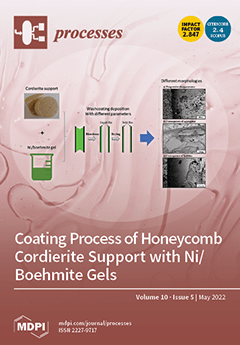Accumulation of electronic waste (e-waste) will place a heavy burden on the environment without proper treatment; however, most ingredients contained in it are useful, and it could bring great economic benefits when recycled. A three-phase alternating current (AC) arc plasma pyrolysis device was
[...] Read more.
Accumulation of electronic waste (e-waste) will place a heavy burden on the environment without proper treatment; however, most ingredients contained in it are useful, and it could bring great economic benefits when recycled. A three-phase alternating current (AC) arc plasma pyrolysis device was designed for resourcing treatment of waste printed circuit boards (WPCBs). This paper focuses on the analysis of plasma pyrolysis gas products, and the results showed that the plasma could operate stably, and overcame the problems of the poor continuity and low energy of single-arc discharge. Air-plasma would generate NO
x contaminants, burn the organics, and oxidize the metals; therefore, air had not been selected as a working gas. Ar-plasma can break the long chains of organic macromolecules to make a combustible gas. Moreover, the strong adhesion between the metals and fiberglass boards would be destroyed, which facilitates subsequent separation. Ar/H
2-plasma promoted the decrease of carbon dioxide and the increase of combustible small molecular hydrocarbons in the pyrolysis product compared with Ar-plasma, and the increase of the H
2 flow rate or plasma power intensified that promotion effect. The percentage of other components, except the hydrogen of CO
2, CO, CH
4, C
2H
4, and C
3H
6, accounted for 55.7%, 34.2%, 5.6%, 4.5%, and 0% in Ar-plasma, and changed to 35.0%, 29.0%, 11.2%, 24.3%, and 0.5% in Ar/H
2-plasma. Ar/H
2-plasma could provide a highly chemically active species and break chemical bonds in organic macromolecules to produce small molecules of combustible gas. This laboratory work presents a novel three-phase AC arc plasma device and a new way for recycling WPCBs with high value.
Full article





